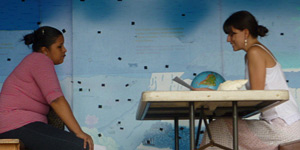By Luz Helena Oviedo
Reaching broad audiences is not often listed in the job description of scientists. However, involvement in such activities is expected and it is an additional value to a scientist’s CV. Students and other members of PCP PIRE have the chance to interact with non-scientific audiences and to develop projects outside the ivory tower. A taste of these opportunities was presented in the second All Hands meeting of the project.

The US Science Festival, the live prep lab at the Florida Museum of Natural History, and interviews with museum visitors in Punta Culebra in Panama and at FLMNH were just some of the venues where PCP PIRE interacted with and reached the general public over the past year.
Opportunities to connect with the public come in many forms and usually trigger those wows and looks of excitement we all enjoy seeing. Describing the immense size of the ancient giant sloth or showing a tiny shark tooth are usually effective prompts. More sophisticated interactions include showing or explaining the process of finding a fossil in the field and then preparing it in the lab. Another simple interaction and yet, exciting for many people, is looking or touching a fossil for the first time—especially if a paleontologist is the one showing it to you.
Kassie Hendy’s presentation informed that more than 30 volunteers worked 1200 hours at the prep lab. Luz Helena Oviedo showed that all of the e-newsletter sections are attractive to recipients and more than 1000 visited PCP PIRE booth at the US Science festival. Meanwhile, Andy Kilmer shared how the design of future PCP PIRE exhibits can be informed by what we now know about museum visitors’ knowledge of past and present biodiversity.
Education and Outreach activities are helpful to increase awareness about fossils in Panama and paleontological research. But they are also valuable experience for scientists in addition to writing scientific papers and grant proposals.
Por Luz Helena Oviedo
Llegar al publico en general no es una tarea que se encuentre comúnmente en la descripción del trabajo de un científico. Sin embargo, se espera su participación en estas actividades, las cuales constituyen un valor adicional en la hoja de vida de un científico. Estudiantes y otros integrantes del PCP PIRE tienen la oportunidad de interactuar con un público no científico y desarrollar proyectos fuera de la torre de marfil. Una mirada a estas oportunidades se presentó en la segunda reunión “All Hands” del proyecto.

El Festival de Ciencias de EE.UU, el laboratorio de preparación en el Museo de Historia Natural de Florida (FLMNH) y entrevistas con los visitantes del Centro Natural Punta Culebra en Panamá y el FLMNH, fueron sólo algunos de los lugares donde el PCP PIRE interactuó y llegó al público en general durante el año pasado.
Las oportunidades para conectarse con el público vienen en muchas formas y generalmente desencadenan esos “wows” y miradas de emoción que todos disfrutamos ver. Describir el inmenso tamaño de un perezoso gigante del pasado o mostrar un diminuto diente de tiburón suelen ser detonadores eficaces. Interacciones más sofisticadas incluyen mostrar o explicar el proceso de encontrar un fósil en el campo y luego prepararlo en el laboratorio. Otra interacción sencilla pero de todos modos interesante para mucha gente, es ver o tocar un fósil por primera vez, especialmente si es un paleontólogo quien lo muestra.
Kassie Hendy presentó que más de 30 voluntarios trabajaron 1.200 horas en el laboratorio de preparación. Luz Helena Oviedo mostró que todas las secciones de boletín electrónico son atractivas para los lectores y que más de 1000 personas visitaron el stand del PCP PIRE en el Festival de Ciencias. Por su parte, Andy Kilmer informó sobre el conocimiento que los visitantes de museos tienen sobre la biodiversidad pasada y presente, y cómo éste puede informar las futuras exposiciones del PCP PIRE.
Las actividades de educación y extensión son útiles para aumentar el conocimiento sobre los fósiles en Panamá y la investigación paleontológica. Pero también son una experiencia valiosa para los científicos, así como escribir artículos científicos y propuestas.